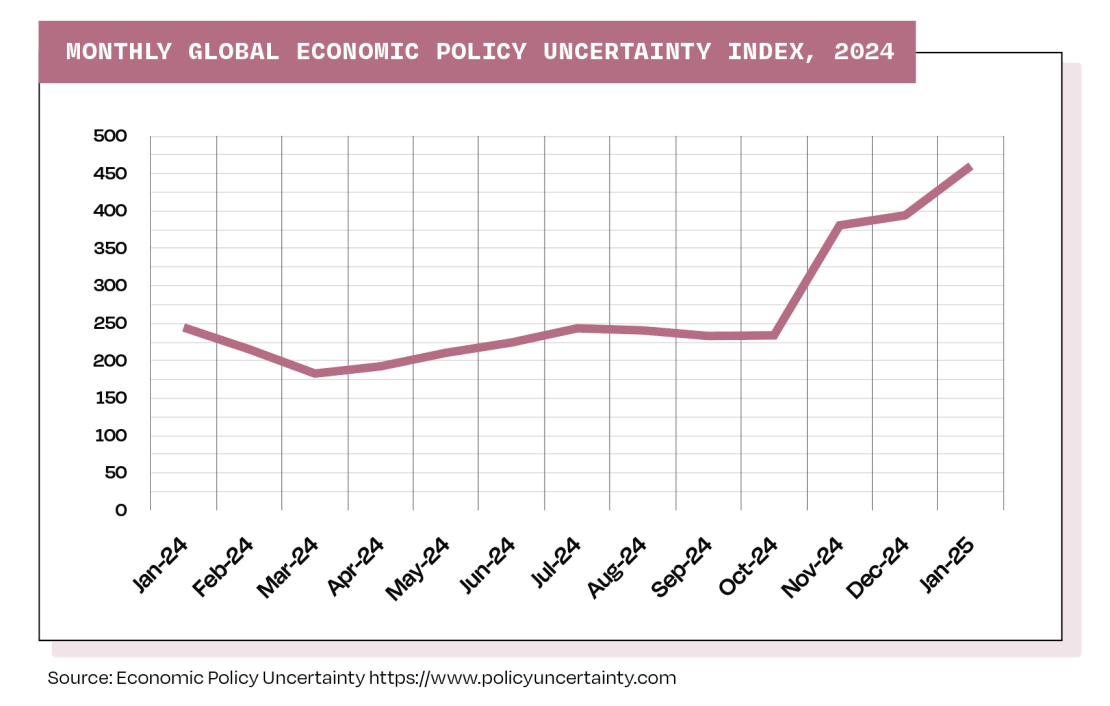Digital finance at a crossroads
Current economic conditions are vulnerable to a range of risks, economic policy uncertainties at the global level are growing due to worsening macroeconomic conditions for some G7 members, while rising geopolitical uncertainties further amplify the downside risks at the global level (see figure).
One source of concern for global economic policy is the uncontrolled growth and spread of digital finance that has been left uncoordinated and unsupervised. Although technological improvements can benefit the global economy, uncontrolled digital risks such as cyber threats can negatively affect stability, while reducing these risks can smooth economic uncertainty. The cyber resilience of financial systems can be strengthened by implementing coordinated regulatory and supervisory strategies.
Pathways to digital currency expansion
In the digital financial system, cryptocurrencies are among the most popular traded assets, but they are entirely deregulated and unsupervised. The benefits of cryptocurrencies are mainly associated with financial inclusion, reduced transaction costs and enhanced payment efficiency; costs depend on the competition they can enhance and the illicit use of digital money. Fraud and market manipulation are not infrequent, to the detriment of consumer trust and market stability.
Due to the vast popularity of crypto assets, central banks in many countries have developed central bank digital currencies. These are digital counterparts to legal money and are managed by the national central bank, with or without the intermediation of the domestic banking system. CBDCs are not cryptocurrencies and are aimed at enhancing financial inclusion, reducing costs, and limiting money laundering and other illicit uses of digital money in the domestic monetary market. Unlike legal money, CBDCs cannot operate outside the domestic market, because there is a lack of interoperability between systems. Although most G7 central banks are conservative and are still at the pilot stage of their CBDC projects, the European Central Bank has reached the final phase of its digital euro project and Europeans will have access to it in the safest possible way by 2026. Similarly, China launched the project for the e-Yuan in 2019, and will introduce a CBDC soon; however, the privacy of e-Yuan trading is not a priority of the People’s Bank of China. The creation of digital currency by the countries in whose currency most foreign reserves are denominated will definitely change the landscape of the monetary system.
A coordinated approach to risk for improved financial stability
The risks of CBDCs in the current global monetary system are mainly related to the lack of effective regulation with regard to consumer protection, privacy of data and anti-money laundering, as well as the lack of interoperability – the possibility of cross-border trade in digital money – and the disintermediation of the banking system, as consumers will prefer a deposit at the central bank rather than a private bank. Although the technology cannot be limited, a lack of coordination in managing these risks can affect financial stability at the global level.
Given the need to reduce potential sources of risk to financial stability, at their Kananaskis Summit G7 leaders should agree on principles underpinning the smooth regulation and supervision of digital financial intermediaries and trades. The Financial Stability Board set the Global Regulatory Framework for Crypto-Asset Activities based on the principle of ‘same activity, same risk, same regulation’. This framework provides a strong basis for ensuring that crypto-asset activities are subject to consistent and comprehensive regulation, commensurate with the risks they pose, while supporting responsible innovations potentially brought by technological change. Following the positive growth rates of digital markets and the preventive and constructive approach taken over the last 10 years, a market-based approach, as opposed to a strict regulatory one, is more likely to prevail among G7 members.













